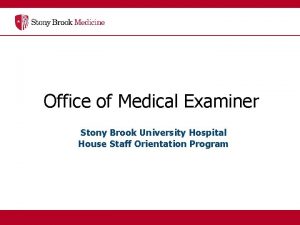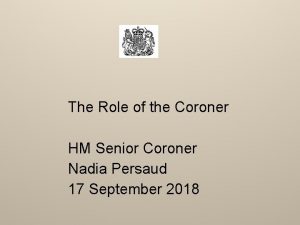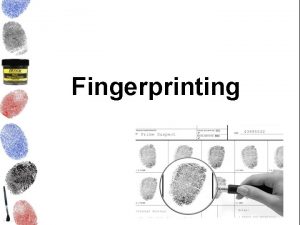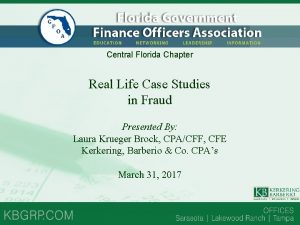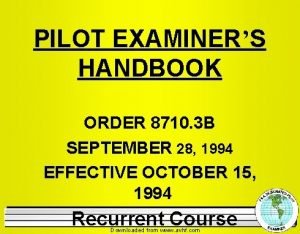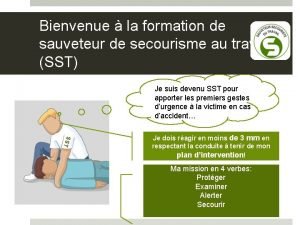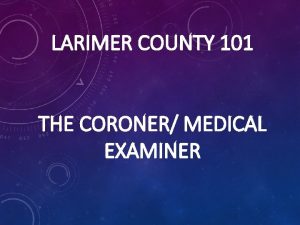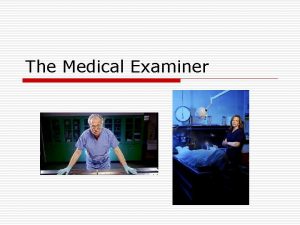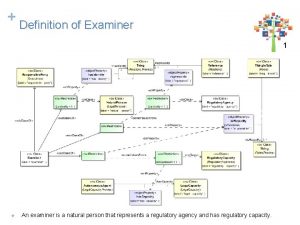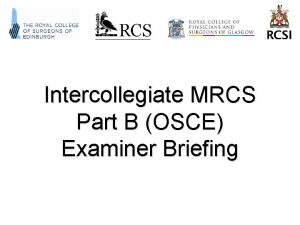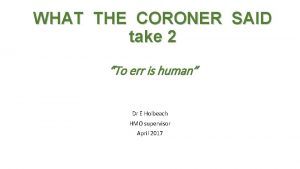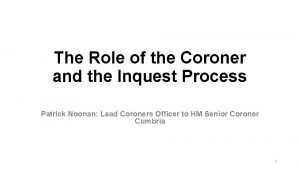Medical Examiner or Coroner Medical Examiner vs Coroner















- Slides: 15

Medical Examiner or Coroner

Medical Examiner vs Coroner Medical Examiner • Office of Medical Examiner was established in the early 1900’s • Appointed to position • Forensic Pathologist (Physician with additional training) • Identify the body • Performs autopsies • Determine time, cause, manner and mechanism of death • Sign Death Certificate • Notify the next of kin and return the personal belongings of the deceased

Medical Examiner vs Coroner • Coroner began as a Crowner in England in September of 1194 • Elected to the position (resident and voting age) • Do not have to be a medical doctor • Identify the body • Cannot perform autopsies • Signs the death certificate • Notify the next of kin and return the personal belongings of the deceased

Medical Examiner vs Coroner • Using your notes create a Venn Diagram that compares a Medical Examiner and a Coroner

The Cause, Manner and Mechanism of Death • The cause of death is the event that starts the process of dying. For example, a heart attack or a gun shot wound. • The manner of death is the way someone dies. There are 5 manners of death: 1. Homicide 2. Suicide 3. Natural 4. Accident 5. Undetermined

The Cause, Manner and Mechanism of Death • The mechanism of death is the physiological reason the body stops working. For example, extreme blood loss. • Practice: A victim dies from a stab wound from a domestic disturbance. What is the cause, manner and mechanism of death?

The Cause, Manner and Mechanism of Death • Practice: An elderly lady was found dead in a chair at her home. What is the cause, manner and mechanism of death? • Practice: Robin Williams death. What was the cause, manner and mechanism of death?

The Time of Death • A range for the time of death is determined using the following information: • 1. Livor Mortis • 2. Rigor Mortis • 3. Algor Mortis • 4. Stomach Contents • 5. Decomposition – body temperature – chemical composition of eye fluid – Insect activity

The Time of Death • Livor Mortis is the pooling or settling of blood. This condition is also known as the color of death or lividity. • When the heart stops beating, blood will settle in the lowest parts of the body. • Lividity begins to show 2 hours after death. • Discoloration is permanent after 8 hours. • Between 2 and 8 hours, if the skin is pressed, the color will fade. After 8 hours, if the skin is pressed, the color will remain.

The Time of Death • Lividity will also indicate if the body has been moved. For example, if livor mortis is present on the back of a victim that is found on their side then the body has been moved.

Livor Mortis

Livor Mortis

The Time of Death • Rigor Mortis is the temporary stiffness of the body. • The process begins approximately 2 hours after death. • It begins at the head and moves down to the legs. • After 12 hours the body is at the stiffest state. • The stiffness will gradually disappear after 3648 hours.

Rigor Mortis

The Time of Death • Algor mortis is the cooling of the body after death. • On average, a body cools at 1 to 1. 5 degree per hour. • Factors such as weight, clothing, ambient and body temperature all affect the rate at which the body cools.
 Accoleds
Accoleds Vermont medical examiner
Vermont medical examiner Medical examiner vs coroner
Medical examiner vs coroner Nc medical examiner and coroner guidelines
Nc medical examiner and coroner guidelines Dr stephen evans ottawa
Dr stephen evans ottawa Medical examiner
Medical examiner Dr kevin horn medical examiner
Dr kevin horn medical examiner Senior coroner
Senior coroner Gort 5 scoring
Gort 5 scoring Kansas assessment examiner's manual
Kansas assessment examiner's manual The study of fingerprints
The study of fingerprints Rita crundwell american greed
Rita crundwell american greed Attendance certificate for external examiner
Attendance certificate for external examiner Flight examiners handbook
Flight examiners handbook Vessel examiner test answers
Vessel examiner test answers Sst mission
Sst mission





